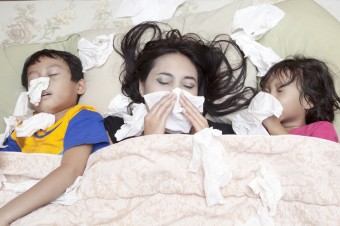Why Snot is Green and Yellow
 Snot is an essential part of a healthy body (no, really), and its color and consistency can give you a lot of information about what’s going on in yours at any given time.
Snot is an essential part of a healthy body (no, really), and its color and consistency can give you a lot of information about what’s going on in yours at any given time.
What is mucus?
Produced in the lining of the sinuses, nose, throat, mouth, lungs and even digestive tract, mucus provides a protective coating over tissue surfaces, keeping them moist and in proper order. Comprised of enzymes, antibodies and protein, one of mucus’ primary roles is to catch and kill invaders, including viruses, bacteria and even particles.
Why is there sometimes so much of it?
On a good day your body will produce between 2 to 3 pints of mucus. On a bad day, such as during allergy season or when you have a cold, the tissues that make mucus react to the distress call (often sent out by histamine in reaction to an invader) and put the snot engines into high gear.
What does it mean when it’s yellow or green?
Mucus is clear when you’re healthy and have no serious invaders. However, when bacteria or viruses attack, it will turn yellow or green due to the influx of iron-containing enzymes including myeloperoxidases, other oxidases and peroxidases. These enzymes are used by white blood cells, namely polymorphonuclear granulocytes, to help ingest and deactivate bacteria through an oxidative process. The combination of dead white blood cells, used up enzymes and eaten bacteria, all of which still contain a fair amount of iron, results in the green or yellow color.
Notably, the longer snot stays in your sinuses, the greener it will get.
What does red or brown snot mean?
Blood, but not necessarily that much of it. When you blow a lot, the tiny blood vessels inside your nose can burst, causing a bit of bleeding to come out with your mucus.
What if it’s dark brown or black?
Smokers and coal miners often report black mucus, and people who are exposed to a fair amount of dust and dirt will frequently have a bit of brown in their snot. The color actually demonstrates that the mucus is working, catching those tiny particles before they have a chance to invade someplace really sensitive like your lungs.
How can I limit my mucus?
Antihistamines block the mechanisms that trigger snot production, but sometimes cause dizziness and headache. Likewise, decongestants and expectorants provide relief, but often have similar side effects as well as nausea.
More natural methods for phlegm reduction include inhaling steam (either with your head covered by a towel over a steaming pot or in a shower) and nasal rinsing like with a neti pot. Drinking plenty of fluids is said to help as well.
If you liked this article, you might also enjoy our new popular podcast, The BrainFood Show (iTunes, Spotify, Google Play Music, Feed), as well as:
- Is Eating Your Boogers Good For You?
- About 85% of People Only Breathe Out of One Nostril at a Time
- Why Do People Seem To Get More Colds In The Winter?
- Why Your Nose Gets Runny When It is Cold
- Why Spicy Foods Can Cause Your Nose to Run
Bonus Facts:
- Facial tissues are big business and in 2012, Kleenex boasted a brand value of $3.1 billion and had annual sales of $1.7 billion. In 2010, the company spent $51.9 million on advertising (compared with Puffs’ measly $29.5 million). In a similar vein, allergy drugs in the U.S. are expected to have revenues in excess of $14.7 billion by 2015.
- In a 2002 study, it was reported that the average adult loses 8.7 hours of work time each year for their own colds, and 1.2 hours of work attending to their sick kids (under age 13). The study’s authors estimated that the loss in productivity amounted to about $25 billion annually.
- From ancient times through the Middle Ages, certain groups believed the human body was filled with four humors, black bile, yellow bile, blood and phlegm, and that the right balance of all four was necessary for optimum health. In addition, each humor corresponded with a season, an element, a body part and certain personality traits. Phlegm was associated with winter, water, the brain and patience, peacefulness, calm and thoughtfulness.
- Experts say children are developmentally able to blow their noses by age 2. They recommend teaching the process by first showing them how to blow out of their mouths (like blowing bubbles) and then using the nose.
| Share the Knowledge! |
|





5 comments